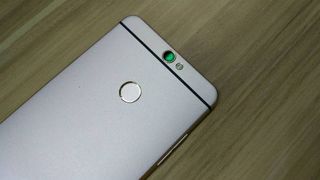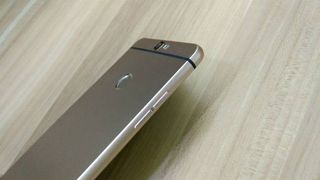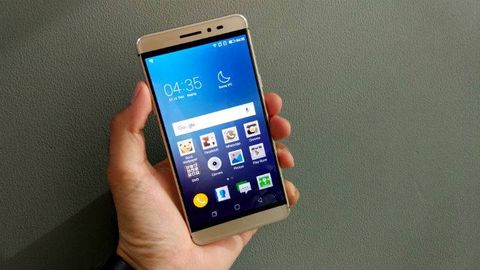TechRadar Verdict
Coolpad is playing the cards with its dual-system security feature and has loaded the Coolpad Max with decent hardware. However as far as the overall performance goes, the sub Rs 25,000 price category has much better options in the form of Xiaomi Mi 5, Lenovo Vibe X3, Moto X Style, etc.
Pros
- +
Premium design
- +
Excellent build quality
- +
Nifty dual-security feature
- +
Snappy fingerprint sensor
Cons
- -
Battery performance could have been better
- -
Boring user interface
- -
Low on computing power
- -
Mediocre camera performance
- -
Optimisation issues
Why you can trust TechRadar
Design 4/5
Features 4/5
Performance 3/5
Usability 3/5
Value 2.5/5
Display: 5.5-inch 2.5D curved Full HD (1920x100) display, Gorilla Glass 4 coating
OS: Android 5.1 Lollipop with Coolpad UI
CPU: 1.5GHz octa-core Qualcomm Snapdragon 617 CPU, 4GB
Storage: 64GB storage, microSD support by up to 64GB
Cameras: 13MP rear camera (dual-tone LED flash), 5MP front camera
Connectivity: Wi-Fi, 3G/4G/2G, GPS, Bluetooth, USB Type C charging port, USB OTG
Battery: 2,800mAh
Dimensions: 152.00 x 75.70 x 6.90mm
Weight: 170 grams
Price: Rs 24,999
Chinese smartphone maker Coolpad might be a new name in the Indian smartphone market but the company has a lot going in its favour. Coolpad entered Indian market and raised the bar with Coolpad Note 3, which was the first sub Rs 10,000 smartphone in India with a fingerprint sensor. The company extended its product line-up with Coolpad Note 3 Lite and the recent Coolpad Note Plus in the value for money category.
Recently, Coolpad forayed in the upper mid-range smartphone market with the launch of its latest handset- Coolpad Max, which features a metal body, 2.5D curved-edge glass display and a decent spec sheet. But the highlight of the smartphone is its 'dual-system' security mode, which allows users to isolate their personal stuff from work and keep two distinct accounts for Facebook, WhatsApp and other social media applications.
Is it enough to create ripples in the market or the company has made an early attempt in the upper mid range smartphone category with the Coolpad Max? Let's find out.
Design

Coolpad Max is indeed a step up in terms of design when compared with the previous affordable smartphones from the company. And that is quite understandable as it costs almost three times more than most of its Coolpad Note series smartphones.
The smartphone comes with a full-metal unibody and feels quite robust and well constructed. The 2.5D curved glass at front adds to the premium design and comes with Gorilla Glass 4 protection. The rounded edges give the Coolpad Max an ergonomic structure, which otherwise feels a bit large to operate with one hand. The Xiaomi Mi 5, which is also priced at Rs 25,000 is a better fit for one hand operation than the Coolpad Max, but that is also because the former features a smaller 5.15-inch display.
Coolpad Max's design also reminds us of iPhone 6S Plus, especially the Rose Gold variant. However that's not a bad thing as the latter is one of the best looking handset in the market.
The front has a 5MP shooter on top of the display along with an earpiece and a notification LED. The bottom has the microUSB slot (no Type C) and two speaker grilles, one of which is an actual speaker and the second is just for adding symmetry to the design. You will find the power button and SIM/microSD tray on the right side, which can accommodate one nano-SIM card and a second nano-SIM card or a microSD card. The volume buttons are on left side. The rear has fingerprint scanner with a nice shiny ring around it and a 13MP camera paired up with dual-tone LED flash.
The phone will be available in Royal Gold and Rose Gold colours.
Hardware

The Coolpad Max has a 1.5 GHz octa-core Qualcomm Snapdragon 617 CPU, 4GB of RAM and 64GB internal storage that can be expanded by up to 64GB via microSD card.
The specifications sound rather impressive on paper with one big flaw- the Snapdragon 617 CPU, which is rather unforgivable at a price tag of Rs 25,000. Just to give you a better understanding, this is the same CPU that powers up the Moto G4 and G4 Plus which are priced under Rs 15,000. At its price-point, Coolpad Max competes with Xiaomi Mi 5, which is powered by the flagship Snapdragon 820 SoC.
As far as connectivity goes, Coolpad Max has Wi-Fi, Bluetooth 4.0, A-GPS, FM radio, and USB OTG. There's 64GB inbuilt memory with microSD support by up to 64GB. Coolpad Max misses on NFC and infrared, which are offered in some of the smartphones priced around Rs 25,000.
Display

The 5.5-inch display did not disappoint us. It is fairly bright, feels vibrant and offers crisp content. The pixel density rests at 401ppi, which is good for watching videos and playing games, however we noticed reflections at the edges of the screen, which creates a problem if you are using the smartphone in direct sunlight.
The display gets a 2.5D curved Gorilla Glass 4 protection.
Performance
When it comes to computing power, the Snapdragon 617 SoC is not a match to the flagship Snapdragon 820 SoC. The smartphone suffers from frequent lags and hiccups and the day to day performance is just not as smooth as you would like.
The keyboard slows down occasionally; there is a delay of a second or two while launching applications with random lags and jitters in everyday usage. What's surprising is that games like Subway Surfers and Asphalt run reasonably well, which makes us question the optimization of Coolpad's UI.
The keyboard lags a lot, and the RAM management is extremely poor. With just a few applications open, the available RAM drops to about 500 MB.
However, we found the fingerprint sensor extremely responsive. It does not waste time in reading the fingerprint and works fine most of the times in unlocking the smartphone. The audio performance is also decent and the speaker delivers loud and clear sound.
Software

The Coolpad Max runs Coolpad's own Cool UI running on top of Android 5.1 Lollipop.
Above and beyond the customization done by Coolpad on its UI, the company has adopted a Gold colour theme for the Coolpad Max. The Gold theme, supposedly done in a bid to look premium ends up looking extremely tacky and garish.
Coolpad has skinned even the icons for popular apps like Facebook and Whatsapp in the same Gold hue, which cannot be changed even if we apply another theme and feels irritating at times. The Chrome icon for instance resembles the camera icon for stock Android and that is very confusing.
The interface thus lacks polish and feels unfinished. The icons look extremely amateurish and the overall experience is not user friendly.
The Coolpad Max also comes bundled with a fair amount of bloatware which bars the supposedly 'premium' experience.
Spaces - private/main
The distinctive feature of the smartphone, one which Coolpad have been highlighting tremendously, is its 'Dual-System' security feature.
The phone is equipped with Dual Isolation technology, which means it has a separate external open system that handles all features normally expected in a smartphone and a secure internal system which encrypts user's sensitive data such as calls and text messages. In addition, the smartphone also allows user to have two accounts on services such as WhatsApp, Facebook, Messenger and so on.
The best way to describe how this feature works in day to day use is that it feels like having two separate smartphones. If you sign into your Facebook account or configure Whatsapp in one mode, say the private space, they exist solely in the latter. Once you switch back to the main space, you can log into Facebook with another ID.
In this way, a person can configure the main space with his work accounts and the private space with his personal accounts. The private space is also encrypted further safeguarding your personal data.
Access to the private space can be locked with a passcode or through the fingerprint scanner. Additionally, one can also configure if they want notifications from the accounts in the private space to come in the main space. There is also the option to share files and data between the two spaces.
However, this concept has its limitations in its current iteration. The biggest drawback is the fact that presently, only notifications from Messages, Facebook and Twitter in the private space can show up in the main space. If you have an app like WhatsApp or Hike configured in the private space, you won't be able to receive any notifications unless you switch to the private space.
Camera

The rear 13MP camera with a dual tone LED flash is rather mediocre, not befitting a Rs 25,000 smartphone. The images captured are not bad by any means, in fact they are crisp and vibrant, but they lack detailing and have a lot of noise.
The problem for the camera is the fact that at this price point, the bar is raised significantly higher than the usual sub Rs 10,000 price range Coolpad is used to.
The front camera is decent for the occasional social media selfie, but not for much else.
Battery

Coolpad Max is backed by a non-removable 2,800mAh battery unit. It seems a bit underpowered but gets the support of Qualcomm's Quick Charge 3.0, which can quickly boost up the battery and works really well in real life. And that is something you actually need with the Coolpad Max as the 2,800mAh battery unit is not powerful enough to last for a day with moderate to heavy usage. You need a charger or a power bank handy with you if you are always hooked to your smartphone for browsing web pages, playing gaming, social networking and other everyday tasks.
Likes
Coolpad Max is designed very well and looks quite premium. The smartphone's display is decent and the dual-security feature is a nifty addition that will come handy for users who want to keep their work and personal stuff separate. The fingerprint sensor is very snappy.
Dislikes
The Snapdragon 617 CPU does not complement other aspects of the smartphone and offers a mediocre performance. The phone suffers from memory management issues and is clearly not well optimized. Besides, the UI is not user friendly and the camera and battery performance is not the best in sub Rs 25,000 price range.
Verdict
Coolpad is betting on its dual-system security feature and seems to have priced itself out of the market when it comes to other aspects of the smartphone. No doubt the new handset is designed well and features a stellar build quality, excellent fingerprint senor and a decent display. However, the smartphone is not a catch at Rs 24,999 price-tag. The cameras are mediocre, performance is questionable and the UI is an unappealing mess.
If you fancy the dual-mode security feature and can compromise on features like 4K video recording, lag free 3D gaming and camera performance, then it can cut a deal otherwise the market has much better options in the form of Xiaomi Mi 5, Lenovo Vibe X3, Moto X Style, etc.
Rohit Arora is the Senior Correspondent at Gizbot, OneIndia. He has been exploring technology since early 90s and started working with Print media in 2014. After writing for PC Quest, Voice & Data and Data Quest for over 14 months, I joined TechRadar in 2016 (Noida). Rohit provides strategic ideas to leading tech brands for new product launches and marketing campaigns.


